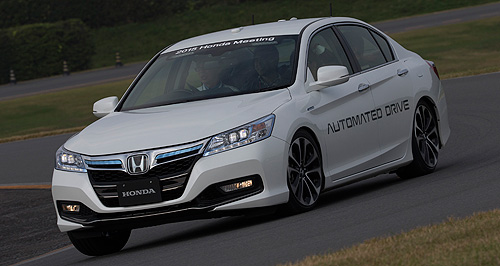Make / Model Search
News - HondaHonda senses safe futureIn a jam: Honda’s prototype Legend showcases its Traffic Jam Assist technology. Autonomous Hondas to hit Japanese roads by 2020, but Australia much later28 Oct 2015 By TIM NICHOLSON in TOCHIGI HONDA has detailed some of its autonomous driving technology this week while announcing that it expects to have full self-driving vehicles fully operational and on sale in its home market during the next decade. The Japanese car-maker is the latest manufacturer to confirm its intentions to develop autonomous tech, with prestige and mainstream brands alike already showcasing their work. Audi, Mercedes-Benz, BMW, Volvo, Renault-Nissan, PSA Peugeot Citroen, Jaguar Land Rover, Tesla, General Motors, Mitsubishi and even Tata Motors are all deep into the development process, with a number of brands nominating 2020 as their target date for the launch of a mass-production driverless car. Honda, however, has been developing self-driving systems since 1986 and the latest example of its work is part of its desire to eliminate all road crashes. At a global media gathering held at Honda’s research and development facility in Tochigi, Japan, GoAuto experienced the company’s new autonomous driving technology from the rear seat of an Accord Hybrid development mule. Honda has already tested the driverless technology on public roads, using an 8km section of the Shuto Expressway in Tokyo to highlight manoeuvres such as entering, merging, overtaking and exiting. Speaking with GoAuto at the media drive event, Honda Australia director Stephen Collins said that while autonomous vehicle technology was on the company’s radar for adoption Down Under, a fully self-driving car would not be seen for some time. “As we heard today, and my personal view is, it is still a fair way off,” he said. “But we have done a pretty good job in bringing some of the advanced driver safety systems to our market. “We are constantly talking about it, we are trying to put as much of those types of technologies on our top-spec cars.” Mr Collins reiterated what some of Honda’s safety engineers said at the event, suggesting that the technology will be rolled out and ready to go globally with government support “somewhere between 2020 and 2023, maybe closer to 2030”. While acknowledging the South Australian government’s efforts in supporting self-driving systems, Mr Collins said more support was required before autonomous cars take to local roads. “As we saw today the technology is there, it is all the other complicating factors that make it tough,” he said. During Honda’s drive event, GoAuto experienced the technology from the rear seat of a Honda Accord Hybrid which is specially equipped with the technology that is still under development. A Honda engineer sat in the driver’s seat but did not touch the steering wheel once. The short journey was around a small track at the Tochigi facility, and the route had been pre-loaded into the system. Honda’s system uses stereo cameras, long- and mid-range radars and six range finders in conjunction with GPS satellite navigation and, where available, vehicle-to-vehicle or vehicle-to-infrastructure communication. A feature called Target Line Tracing Control ensures that the vehicle maintains its line, finding a smooth route and selecting a safe line via a multi-layer algorithm. If the vehicle starts to deviate, the vehicle is kept in the lane according to the position of road markers, obstacles and other factors. It controls the steering, braking and acceleration where necessary. With each lap of the track, the vehicle became progressively faster. Through a series of mid-speed corners, the feeling of watching the driver relinquish control of the vehicle to the technology, while traveling at relatively high speeds, was disconcerting at first. Perhaps in time with a few more laps under our belt we would have developed a bit more trust, but the sensation was strange. That is not to say we found a fault with the technology itself. We didn’t. The Accord Hybrid even took us back to our original starting point safely, and quietly. Honda also showcased its new Traffic Jam Assist system that functions like advanced adaptive cruise control by following a vehicle ahead without requiring accelerator or brake input from the driver, although he or she does need to steer the wheel as needed. From the back seat of a Japanese-market Legend, we saw the system in action, cleverly following behind another Legend, and even being interrupted by a Honda City sedan that cut into traffic in front. The system acted immediately, smoothly lowering speed to allow the City to enter the lane. Similar technology is already seen in other brands such as Mercedes-Benz, but the Honda system, which operates at higher speeds than a lot of city autonomous braking systems do, would be ideal for peak-hour highway driving and even on the open road. It falls under the Honda Sensing safety tech banner that already includes a Collision Mitigation Brake System, Collision Mitigation Throttle Control, Road Departure Mitigation, Pedestrian Collision Mitigation Steering System, Adaptive Cruise Control with Low-Speed Following, Lane Keep Assist System, Lead Car Departure Notification System and Traffic Sign Recognition. Traffic Jam Assist is yet to be made available on an Australian-spec Honda, but will likely arrive on a top-spec variant of one of its models soon.  Read more |
Click to shareHonda articlesResearch Honda Motor industry news |












Facebook Twitter Instagram